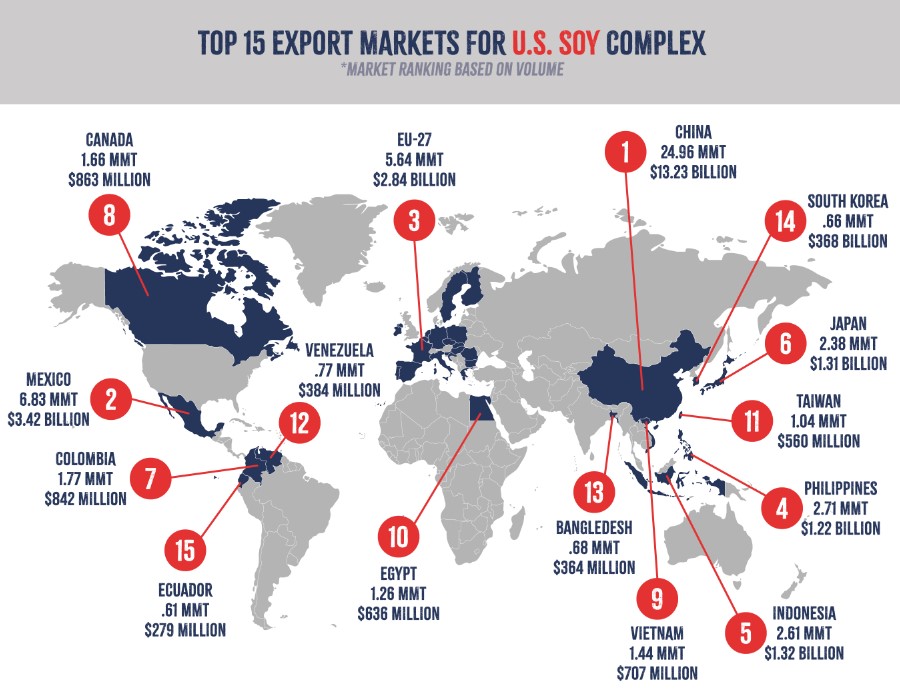
(Photo: Iowa Soybean Association / File Photo)
Growing markets for U.S. soy
April 29, 2025 | Kriss Nelson
For the past 20 years, the United States Soybean Export Council (USSEC) has been working to create preference, open markets and increase demand for U.S.-grown soy.
The U.S. economy benefited by $31.2 billion from soy exports last year, a record year for soybean meal exports. USSEC deserves significant recognition for its work in maximizing U.S. soy's global use, value and market access, says Randy Miller, a farmer near Lacona.
“Without USSEC, the growing demand for soy in other countries would be nonexistent,” says Miller, Iowa Soybean Association (ISA) farmer director representing the American Soybean Association (ASA) on the USSEC board. “There's no other organization that can elevate a preference for U.S. soy, differentiate the benefits to use U.S. soy over soy from other regions and attain market access for U.S. soy.”
Bridging industries
When farmer directors from ASA and United Soybean Board started USSEC as a membership organization, they challenged USSEC to create close working relationships with exporters and allied industry firms.
“By becoming a membership organization, we invited exporters and allied industry members to become members of the United States Soybean Export Council,” says Paul Burke, USSEC's executive director of Regional Agricultural Promotion Program (RAPP) coordination and marketing operations. “If you have a membership organization, you have to have robust membership services, and they have to see value out of that. That was one of the initial challenges. Within the first year, we had 50 members, and we have grown to 117.”
Developing markets
Burke highlights India, China and aquaculture as some of USSEC's top successes of the past 20 years, funded by the combination of the U.S. soybean checkoff, USDA Foreign Agricultural Service (FAS) matching funds, and industry contributions.

Influence in India
U.S. soy has been involved in the India market since 1996. At that time, the country's feed, poultry and aquaculture industries were underdeveloped.
“Back then, India was a major exporter of soybean meal,” Burke says. “They exported soybean meal throughout Asia, including Pakistan, Bangladesh and as far away as Korea. India's underdeveloped poultry and feed industry could not absorb all the Indian soybean meal.”
USSEC's market development efforts has helped modernize India’s poultry and feed industries, thereby increasing consumption of domestic Indian soybean meal. As domestic soybean meal usage strengthened, India’s soybean meal exports decreased.
“Now, because Pakistan and Bangladesh, for example, can no longer depend on India, they've established a soybean-crushing industry and are importing U.S. soybeans,” says Burke. “This is an example of where soybean farmer investments have made ripple effects that don't show up in export numbers but in terms of large markets opening up in those regions.”
Catalyst to protein expansion
U.S. soy began making its presence known in China in 1982. Then, China was an exporter of soy, with the feed and livestock industry in turmoil.
“We played an integral part in re-establishing their feed, poultry and swine industry,” says Burke. “As their economy began to take off, there was an incredible pent-up demand for animal protein. You had a population of one billion who might have gotten pork once a year. We were an incredible catalyst to China's livestock development.”
Thriving on soy
China used zero soybean meal in aquaculture diets 33 years ago. Burke says USSEC was challenged to prove that soy belonged in the aquaculture space.
Feeding trials began comparing traditional diets to those of up to 50% soy. Also, an investment from the Iowa Soybean Association helped introduce In-Pond Raceway Systems, allowing fish farmers to be more profitable by lowering their operation costs.
“We were able to convince the aquaculture industry that not only will fish eat soy, but thrive on soy,” he says. “Just in China alone, we have gone from zero soybean meal being used in 1992 to well over 15 million metric tons included just in aquaculture diets.”
Success has its challenges
USSEC has struggled against difficulties related to soy's use in feed and political issues in various situations.
Despite trade tensions, Burke says China is still the United States' largest export market of soy. He’s determined to maintain and strengthen relationships with importers, crushers and animal feed manufacturers.
“Our message is very clear. We are your partner; we have been here all this time, and we are not going away. We can continue to have a relationship that goes beyond politics,” he says. “In the end, China will reward the U.S. for being their long-term friend and not abandoning them.”
As Brazil continues to bring more soybeans to the market by increasing acres, Burke says USSEC is continuing to differentiate the high quality of U.S. soy to global customers.
“We have been ramping up and gathering the science that shows U.S. soy is a better investment. We have the data to support the impact of good quality versus bad quality of soy protein,” he says.
Miller explains that checkoff dollars enabled USSEC's global outreach, allowing them to meet with international buyers and highlight the quality of U.S. soybeans.
“Most buyers don't understand the quality issues and differences,” says Miller. “I have been fortunate enough to travel around the world. You can pick up a handful of soybeans or soybean meal and I can tell where it comes from based on the quality.”
The future
It's been 20 years, and USSEC is just getting started.
“Of all the commodities economists point out the world is going to need more of, soy is at the top of the list,” says Burke. “The U.S. soy industry is well-positioned to take advantage of a growing world population and global economy for the next 20 years and beyond.”
Contact Kriss Nelson at knelson@iasoybeans.com
Back